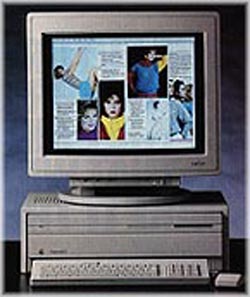
Macintosh IIfx
The Macintosh IIfx was released in 1990 as an upgraded version of the Macintosh IIx. It's headlining feature was its processor - a 40MHz 68030, the fastest in any Macintosh upon release. It was also the most expensive Macintosh, starting at nearly $9000.
Specifications
| Spec | Details |
|---|---|
| Release Date | March 1990 |
| Discontinuation Date | April 1992 |
| Processor | Motorola 68030 @40MHz FPU: Yes Bus Speed: 40MHz |
| RAM | 8x 64-pin SIMM Slots - 4MB Standard - 128MB Maximum |
| Hard Disk | SCSI - 80 or 160MB Standard |
| Graphics | Varied by video card used |
| Audio | Internal Speaker |
| Internal Drives | 1 or 2 Auto-inject 3.5" 1.44MB Floppy Drives |
| Expansion | 6x NuBus Slots |
| Networking | None |
| Other I/O | - 2x ADB - 2x Serial - 1x DB25 SCSI - 1x DB15 Video Out (on NuBus video card) - 1x Line Out |
| PRAM Battery | Two 1/2AA Lithium Batteries |
| Original Mac OS | System 6.0.5 |
| Maximum Mac OS | Mac OS 7.6.1 |
Upgrades
CPU Upgrade
68040 CPU upgrade cards were available.
SSD Upgrade
Check our page on SCSI SSD replacements for more info.
Resources
 Service Manual |
 Logic Board Schematic |
Capacitor Reference |
|---|
Common Faults & Maintenance
PRAM Battery Leaks
The Macintosh IIfx used two 1/2AA Lithium batteries - one as the PRAM battery, and the "startup battery", which was required to jump-start the soft power circuit in the Macintosh. If this battery is dead, the Mac II won't power on. These batteries are very prone to leaking, and should always be removed if original.
Capacitors
The Mac IIfx shipped with either tantalum or electolytic capacitors on the logic board. The first thing you should do when you get a IIfx is to check which type you have. Be warned though - most boards with tantalum caps will still have two elecrolytic caps in the power circuit. Any surface mount electrolytic cap in the system must be changed out, as the originals leak and will damage the board if left installed. In addition, capacitor C1, if a factory tantalum, is prone to exploding due to being slightly underrated for its application. It is recommended that this capacitor be changed out with one of a higher voltage rating to prevent this failure.
The power supplies in the Mac IIfx are generally reliable, but some of them have Rifa filter caps inside which can explode, releasing a bunch of nasty smoke.
Other Notes
Most original SCSI hard drives for these have gone bad, especially those made by Quantum, which suffer from sticky rubber bumpers in the head assembly.
The floppy drives in these often suffer from eject motor failures due to a gear that falls apart with age. This gear can be replaced without too much trouble.
The Mac IIfx's case yellows with age. A retrobrite process can be used to correct this, if it bothers you. The plastic is not nearly as brittle as Macs from the 90s though.
Page last updated (MM/DD/YYYY): 03/03/2025
Update Reason: page rewritten
Back-Navigation
Home < Macintosh Portal < Mac II < Macintosh IIfx